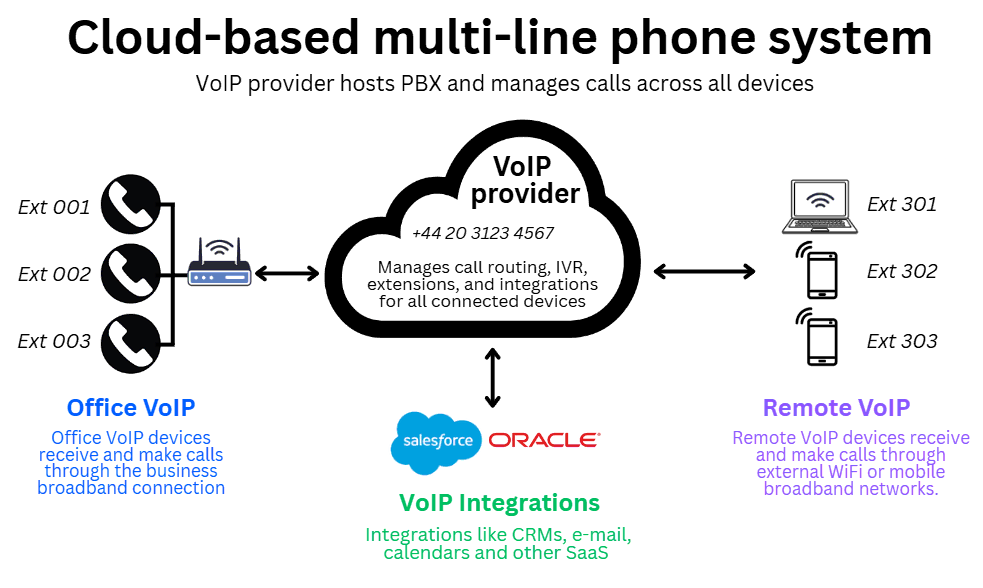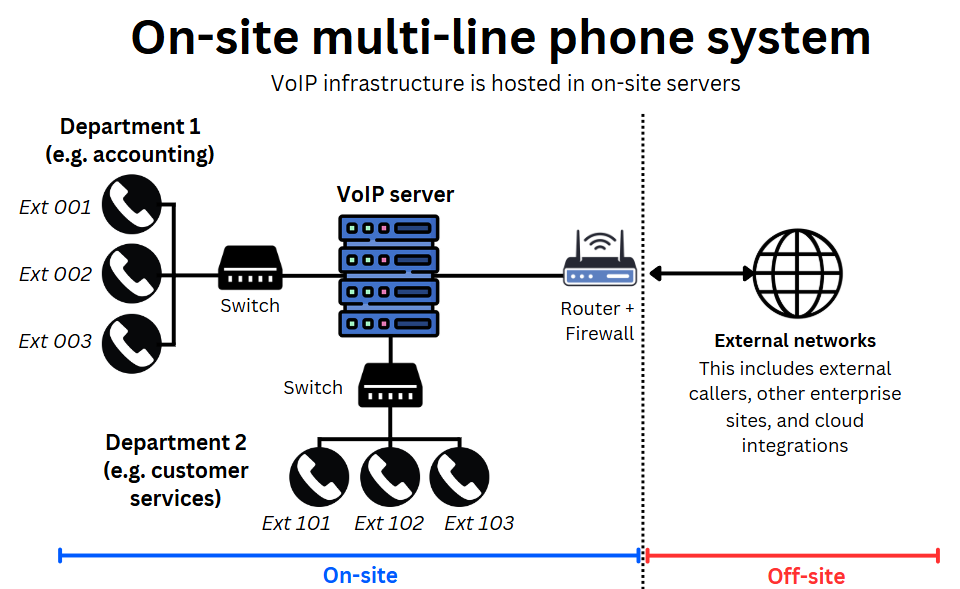Multi-line business phone systems
For many UK businesses, reliable phone communication remains essential for staying connected with customers, partners, and suppliers.
A multi-line phone system provides the structure and features needed to handle high call volumes efficiently, present a professional image, and support flexible or remote working.
This article explains how these systems work, the types available and why they still play a vital role in modern business communication.
Contents:
- What is a multi-line phone system?
- How do multi-line phone systems work?
- Types of multi-line phone systems
- Key features of multi-line phone systems
- Benefits of multi-line phone systems for businesses
- Costs of multi-line phone systems
- Best multi-line phone systems
What is a multi-line phone system?
A multi-line phone system enables a business to connect multiple phones or extensions to a single main phone number.
It can handle multiple calls simultaneously and includes features such as call routing, forwarding, and holding, which help manage incoming and outgoing call traffic efficiently.
Customers interact with a virtual receptionist, which greets callers and directs them to the right department.
Behind the scenes, the system utilises a PBX (Private Branch Exchange), which can be cloud-based or installed on-site, to manage call handling.
Older systems that run on ISDN or PSTN lines (using traditional phone cables) are still in use, but many businesses are moving to internet-based business VoIP phone systems.
These offer lower running costs, more features, and are future-proof against the upcoming PSTN-Switch Off.
Multi-line system vs. Single-line phone vs Unified communications
Multi-line phone systems contrast with other simpler and more complex types.
A single-line phone is the simplest, while UCaaS (Unified Communications as a Service) is the most advanced.
Here’s a quick comparison of all three:
| Feature | Single-line phone | Multi-line system | Unified Communications (UCaaS) |
|---|---|---|---|
| Use case | One person, simple needs | Small to mid-sized teams needing call handling | Teams needing calls, video, and messaging in one system |
| Call handling | One call at a time | Multiple calls at once | Multi-channel (calls, video, chat) |
| Features | Basic: dial, answer, voicemail | Transfer, hold, call groups, extensions, menus | Video calls, file sharing, team chat, integrations |
| Typical users | Home workers, small shops | Offices, clinics, support desks | Any business, remote teams, contact centres |
| Scalability | Not scalable | Can grow moderately | Highly scalable |
| Costs | Very low: basic phone line | Around £10–£30 per user/month | From £15–£50+ per user/month, depending on features |
How do multi-line phone systems work?
A multi-line phone system acts as a business’s internal phone network. It manages how incoming and outgoing calls are routed, shared, and handled across multiple users or departments.
It involves a combination of hardware, software, and in many cases, people (receptionists and/or support staff) working together to ensure smooth communication.
Let’s explore how these systems work behind the scenes.
Multi-line phone system hardware
The physical setup varies depending on whether the system is traditional or VoIP-based. However, most systems include:
- Phones and devices: Desk phones, cordless phones, softphones (computer-based apps), headsets, and mobile phones connected to the business number.
- Cabling and connectivity: Traditional systems use internal telephone cabling (often RJ11), while VoIP systems typically use Ethernet cables (CAT5/CAT6). Wireless options like WiFi or mobile networks play a role connecting remote VoIP devices.
- PBX (Private Branch Exchange): The PBX controls the system. It manages how calls are routed internally and externally, including extensions, call queuing, and voicemail. Legacy PBXs units are physical hardware boxes, often installed on-site, while VoIP PBXs are more often cloud-based.
- Access Line: Connects your internal phone system to the outside world. This could be a broadband internet connection for VoIP systems, or an ISDN/PSTN line for legacy systems. Typical broadband connections include:
- On-site and cloud systems: Leased line broadband, Point-to-point leased lines, or Business Ethernet links.
- For remote workers: Full fibre residential broadband with an office connection.
- Networking Equipment (VoIP only): VoIP systems require additional network infrastructure at the local area network (LAN) level:
- Network Switches: Manage internal call traffic across devices.
- Firewalls: Secure your call data from external threats.
- Routers/Modems: Provide internet access needed for VoIP calling.
- VoIP Gateways: SIP Trunking setups, where an old PBX is adapted for VoIP require VoIP gateways to translate analogue signals into digital calls.
Multi-line phone system software
The software is what brings the system to life, controlling how calls behave and providing tools for configuration and user access. It includes:
- PBX control software: Both VoIP and traditional PBX systems have a PBX interface used to set up call flows, configure extensions, manage voicemail, and apply rules.
- IVR software: IVR tools allow you to set up automated voice menus that greet callers and direct them to the right person or department without needing a receptionist.
- Softphone apps: VoIP systems often include desktop or mobile apps that let users make and receive calls as if they were using a traditional desk phone.
- User dashboards: Web portals give administrators access to settings, call analytics, call recordings, and user management, all from a browser. Traditional PBX systems also have one but they are usually more clunky.
- Integrations: Internet-based systems have VoIP integrations to connect with CRM systems, calendars, helpdesk tools, and collaboration platforms like Teams or Slack.
Multi-line phone system call flow
Each type of multi-line phone system works slightly differently under the hood, but the basic process of handling calls is generally the same.
Below is an overview of how these systems manage incoming and outgoing calls.
Receiving calls
When someone calls your main business number:
- The call enters the system through the internet (VoIP) or a traditional phone line (PSTN/ISDN).
- It is directed by the PBX (on-site or cloud-based) according to pre-set rules.
- Most systems will play a greeting or menu through an IVR system.
- The caller can choose an option (press 1 for sales, etc, etc), or be automatically routed based on time of day or known caller ID.
- The call may ring one person, a team of phones (a ring group), or be placed in a queue until someone is available.
- If unanswered, calls can be forwarded to mobiles, transferred to voicemail, or escalated to another team or office location.
- After hours, separate rules can redirect calls or trigger automated messages.
Making calls
For outgoing calls:
- Staff can place calls from any connected device (e.g. desk phone, computer softphone, mobile app) using their assigned extension.
- Internal calls use short extension numbers; external calls go through the PBX and out to the public network.
- The PBX handles outbound routing and applies any dialling rules or restrictions.
- Many systems allow the business number to appear as the caller ID, even if the call is made from a mobile or softphone.
- VoIP systems may also route calls in the most cost-efficient way, using what’s known as least-cost routing through SIP Trunking.
Types of multi-line phone systems
There are several types of multi-line phone systems available today.
Each has its advantages depending on your business size, infrastructure, and technical needs.
VoIP multi-line phone systems
VoIP (Voice over Internet Protocol) systems transmit calls over the internet, using your data connection rather than traditional phone lines. They are flexible, cost-effective, and scalable.
There are two main types of VoIP setups:
Cloud-hosted multi-line phone systems

Your business VoIP provider hosts the system in the cloud, handling maintenance, updates, and scaling.
You connect your phones and devices to their platform via a secure internet connection, usually through a VPN or SD-WAN link.
It is by far the most common type of multi-line phone system in the UK.
Best for: SMEs, home offices, remote teams, or businesses wanting minimal maintenance.
Supports: Virtually unlimited lines, depending on your provider plan and internet bandwidth.
Pros:
- Lower setup costs and predictable subscription-based monthly fees, perfect for small business VoIP
- Easy to scale, maintain, and use remotely
Cons:
- Less customisable
- You rely on the provider for data security and uptime
On-premises VoIP multi-line phone systems

In this model, your business hosts and manages its own VoIP infrastructure on-site. You control the servers, software, and networking equipment.
Best for: Larger organisations or industries like finance and healthcare with strict cybersecurity compliance needs.
Supports: As many lines as the server and network infrastructure capacity. Can support hundreds or even thousands of concurrent calls in larger setups.
Pros:
- Full control over data and configuration
- Better suited to complex internal setups
Cons:
- Higher upfront and maintenance costs
- Requires in-house IT expertise
Traditional PBX and SIP Trunking multi-line phone systems
Traditional PBX systems are physical, on-premise phone systems connected to the PSTN or ISDN via copper phone lines. Inside the business, phones are connected through internal cabling.
These systems have been reliable workhorses for decades, but are now being phased out or adapted using SIP Trunking due to the upcoming PSTN switch-off.
Best for: Businesses heavily invested in their legacy setups, not yet ready to move to full-on VoIP, and are happy to adapt using SIP Trunking in preparation for the Switch Off.
Supports: SIP Trunking can support 4 to 30 simultaneous calls per trunk.
Pros:
- Proven reliability
- No reliance on internet
- Cheaper if you already have the system in place.
Cons:
- Expensive to maintain and scale
- Limited features compared to VoIP, even with SIP trunking.
Key features of multi-line phone systems
Multi-line systems come with a set of features designed to improve how businesses handle calls, collaborate, and integrate with other systems, whether in the office or working remotely:
Core call features
These are the essential tools that support everyday call management and internal communication:
- Call forwarding: Redirect calls to mobiles or other extensions so all calls are answered.
- Call transfer: Move calls easily between staff or departments.
- Call hold & park: Put calls on hold or park them to pick up elsewhere.
- Call queuing: Line up callers during busy periods until someone is free.
- Voicemail: Let callers leave messages when lines are busy or unavailable.
Automation & routing
These features help direct calls efficiently without relying on manual handling:
- IVR menus: Let callers self-direct using voice prompts and keypad choices.
- Auto-attendant: Automatically answer and route calls without a receptionist.
- Ring/hunt groups: Ring multiple phones at once or in order to ensure a team answers quickly.
Remote & mobile features
These options keep staff connected and responsive, wherever they’re working:
- Softphone access: Make and take calls from a laptop or mobile using apps.
- Call flip: Switch live calls between devices without dropping the line.
- Remote extensions: Use office numbers from anywhere, as if you’re at your desk.
Productivity & integration
These tools support business operations by enhancing workflow and data access:
- Voicemail to email: Get voice messages sent straight to your inbox.
- Call recording: Record calls for training, compliance or quality control.
- VoIP analytics: Monitor call volumes, wait times, and staff performance.
- CRM integration: Link calls to customer records and business tools.
Benefits of multi-line phone systems for businesses
While many digital-first businesses now rely solely on platforms like Zoom, Google Meet, or Slack, phone conversations remain an essential channel, especially for industries where customers expect direct, personal communication.
Multi-line phone systems give businesses the structure and tools to handle high volumes of calls professionally and efficiently, without relying on informal workarounds or limited one-call-at-a-time setups.
Here’s what businesses gain from a modern multi-line phone system:
- Supports customers who prefer phone contact: Many customers still trust phone calls over online forms or chatbots, especially when dealing with sensitive or urgent matters.
- Handles high call volumes: Multi-line systems are built to manage dozens or even hundreds of simultaneous calls, with tools like call queues, IVR menus, and auto-routing that keep things flowing smoothly.
- Improves team coordination: Shared lines, internal extensions, and fast call transfers make it easy for teams to collaborate across departments securely and privately.
- Enhances professional image: Features like automated greetings, IVR options, and voicemail routing help even small teams present a polished, enterprise-grade presence.
- Flexible for remote or hybrid work: With softphones and mobile apps, staff can stay connected to the phone system from anywhere, without needing physical desk phones.
Costs of multi-line phone systems
The cost of a multi-line phone system can vary significantly depending on the setup you choose.
Below is a breakdown of how costs are distributed across the three common types installed by UK businesses today, namely:
| SIP Trunking (Modernised PBX) | Cloud-based VoIP | On-premises VoIP | |
|---|---|---|---|
| Setup costs | Low. Reuse existing hardware, but requires PBX reconfiguration and sometimes SIP gateways. | Low/Medium. Besides headsets, minimal hardware needed; setup often included in service. | High. Requires servers, switches, phones, and professional installation. |
| Recurring costs | Low/medium. Pay for SIP trunk lines and basic support. | Medium to high. Per-user/month subscription with bundled features. | Low. No monthly fees, but ongoing maintenance and support costs apply. |
| Scalability costs | High. Adding lines may require PBX expansion or config updates. | Low. Add users instantly through the provider's portal. | High. Scaling requires new licences, hardware, and possible network upgrades. |
| Long-term ROI | Good short-to-mid term. Lower monthly cost if existing hardware is still viable. | Excellent for growing businesses. Predictable costs and easy updates. | Strong for large organisations with IT support, high upfront, but full control over time. |
For more information, visit our full guide to business VoIP pricing.
Best multi-line phone systems
The best multi-line phone system depends on each business’s size, structure, and communication needs.
Below are three real-world examples from UK organisations, each demonstrating how a different type of multi-line system can deliver real operational value.
SIP Trunking: Rankine Thompson Limited (RTL)
RTL, a logistics business, upgraded its legacy PBX system by implementing SIP trunking through Zen business broadband, enabling it to support multiple simultaneous calls across departments without replacing existing infrastructure.
This approach allowed them to retain their on-site hardware while replacing outdated ISDN lines with modern, internet-based connectivity, reducing costs and improving flexibility.
The SIP-based setup also enabled automated destination calls ahead of haulier arrivals, demonstrating a streamlined, multi-line call flow adapted for logistics operations.
Cloud-hosted VoIP: London Ashford Airport
London Ashford Airport replaced its ageing on-premises system with a fully hosted VoIP solution using 3CX, and was implemented by MPR IT Solutions.
The new cloud-based platform now supports internal extensions, remote working, and high call volumes across teams.
Staff can use mobile apps over 4G/5G during outages, ensuring business continuity through broadband redundancy.
The multi-line environment supports multiple concurrent calls, auto-attendants, and voicemail, ideal for streamlining communications in a fast-paced operational setting.
On-premises VoIP: Presto International
Presto International adopted an on-premises VoIP system via Blue Portal to improve communication between its UK and international offices.
The in-house setup provided a more reliable, MPLS-based high-capacity multi-line environment that supported faster internal coordination necessary for time-sensitive product launches.
With full control over infrastructure and call management, the system helped the business reduce delays and maintain seamless contact across time zones.

